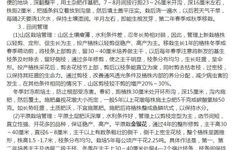(I) Plant Characteristics and Variety Introduction
1. Plant Characteristics: The vine can grow up to 9 meters long, with hollow stems and multiple branches. The leaves are opposite, oval or elongated oval, measuring 3-8 cm in length and 1-3 cm in width, with young leaves having short soft hairs and a gray-green underside. Flowers grow in pairs in the axils or at the tips of flowering branches, with two leaf-like bracts. The flower stalk and flowers have short soft hairs. The corolla is initially white and turns golden yellow after 2-3 days, hence the name Honeysuckle (金银花, Jin Yin Hua). The calyx is small and 5-lobed, with triangular lobes. The corolla is slightly bilabiate, measuring 3-5 cm in length, with the tube and lip approximately equal in length; the upper lip has 4 shallow lobes, while the lower lip is not lobed, and the exterior is covered with soft hairs and glandular hairs. There are 5 stamens, and the ovary is hairless, with the style slightly longer than the stamens, all extending beyond the corolla. The berries are spherical, turning black and shiny when ripe.
2. Variety Introduction: There are many varieties of Honeysuckle, with two notable varieties in the main production area of Shandong.
(1) Da Mao Hua (大毛花, Big Hair Flower): Commonly known as Mao Hua, it has a stout, short, and loose growth habit. Flowers do not grow at the tips of flowering branches but in the leaf axils. The flowering branches are robust, with large flower buds, longer branches that are easy to twine, and bloom later. The root system is well-developed, drought-resistant, and tolerant of poor soil, making it suitable for cultivation in mountainous fields.
(2) Ji Zhua Hua (鸡爪花, Chicken Claw Flower): Flower buds grow at the tips of flowering branches, concentrated like a chicken’s claw. The branches are thick, short, and upright, with a compact growth habit. It blooms earlier than Da Mao Hua, but the flower buds are smaller, making it suitable for dense planting in fields.
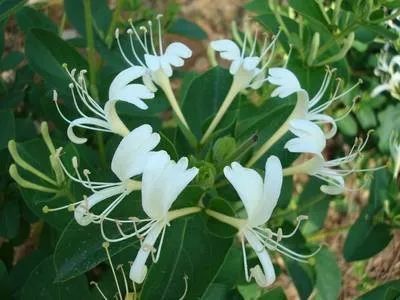
(II) Growth Habits: The root system is well-developed with many fine roots and strong rooting ability. Cuttings and branches that touch the ground can root in less than 15 days under suitable temperature and humidity. A ten-year-old plant can have a root crown diameter of 300-500 cm and a root depth of 150-200 cm, with the main root system distributed in the top 10-50 cm of soil. The fibrous roots mainly grow in the top 5-30 cm of soil. Roots grow fastest from early April to late August. As long as there is sufficient moisture and the temperature is generally not lower than 5°C, the plant can sprout year-round, with the most buds sprouting in spring. Young branches are green and densely covered with short hairs, while older branches lose their hairs, and the bark is brown, later peeling off as new bark forms.
Honeysuckle prefers a mild climate, with an optimal growth temperature of 20-30°C, and thrives in a humid environment with high moisture and good air permeability. However, excessive soil moisture can affect growth, causing leaves to yellow and drop. It prefers long daylight hours; insufficient light can affect photosynthesis, leading to slender, small leaves, increased twining, and reduced flower bud differentiation. Therefore, it should be planted in well-lit areas and is not suitable for intercropping with trees.
Honeysuckle is resilient, drought-resistant, cold-resistant, tolerant of poor soil, and salt-alkali tolerant. Leaves do not fall off at -10°C, seeds germinate at around 5°C, and it can grow in areas with about 0.3% salinity.
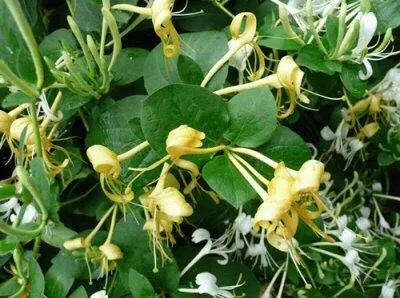
(III) Cultivation Techniques
1. Site Selection and Soil Preparation: Honeysuckle is not very demanding on soil and can be cultivated on barren hills and ridges, with sandy loam being the best. A pH of 5.5-7 is suitable for Honeysuckle growth, with the best soil being fertile, deep, and loose sandy soil. Before planting, apply 30-45 tons of manure per hectare, plow to a depth of 25-30 cm, rake, level, and thoroughly water the area, making beds or not as needed.
2. Propagation Methods: Propagation can be done by seeds or cuttings. Cuttings have a higher survival rate and quicker returns, making them commonly used in production areas.
(1) Seed Propagation: In November, harvest the fruits, wash them in water to remove the pulp and empty seeds, and dry the viable seeds for later use. In April of the following year, soak the seeds in warm water at 35-40°C for 24 hours, then mix with 2-3 times wet sand to induce germination. When about 30% of the seeds split, they can be sown. Before sowing, select fertile sandy loam, plow to a depth of 30-33 cm, and prepare flat beds about 65-70 cm wide, with no limit on length. After preparing the beds, water thoroughly, wait for the soil to dry slightly, level the surface, and mark 3 shallow furrows at a spacing of 21-22 cm, evenly placing the seeds in the furrows at a depth of about 1 cm. After sowing, keep the surface moist, and cover with a layer of straw; spray water every two days, and germination should occur in about ten days. Seedlings can grow up to 1 meter tall in the same year. After growth stops in autumn, cut the upper branches, leaving 30-40 cm, and transplant in early winter or the following spring. The seed quantity per hectare is about 15 kg.
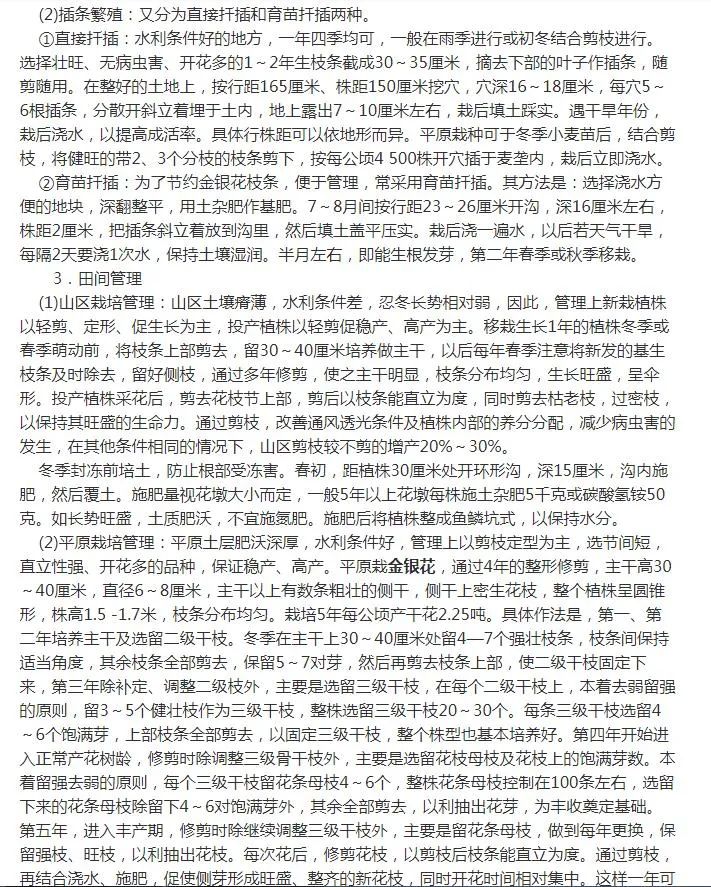
Harvest four times a year.
Pruning Time: Winter pruning should be done before the buds break in spring, combined with shaping. Summer and autumn pruning is generally done after each flowering, retaining appropriate flowering branches while promptly removing crossing branches, twining branches, weak branches, and old or dead branches to improve ventilation and light conditions. Both winter and summer-autumn pruning should be timely and based on the tree’s condition. The principle is to prune heavily in winter and lightly in summer, with short cuts promoting flowering and controlling crown size.
Fertilization and Watering: Adequate water and fertilizer are key to achieving high yields in plain cultivation. In early spring, after thawing, apply 750 kg of soybean cake and appropriate organic fertilizer per hectare for plants over five years old, digging trenches beside the plants. After each flower harvest, apply 225 kg of urea per hectare. Before freezing, apply once more, evenly spreading organic fertilizer on the ground, deep plowing 25 cm at a distance of 30 cm from the Honeysuckle plants to mix the soil and fertilizer evenly, cutting off old lateral roots to promote new root growth, which helps warm the roots and nourish the plants. After each fertilization and thawing, water thoroughly to promote bud and leaf growth.
4. Pests and Diseases and Their Control: Honeysuckle has few diseases, mainly including young honeysuckle brown spot disease, white silk disease, and powdery mildew; pest damage is more severe, mainly from aphids, coffee borer beetles, wood-boring moths, and inchworms.
(1) Honeysuckle Brown Spot Disease: This is a fungal disease. After infection, the leaf spots are round or angular, yellow-brown, and gray mold may appear on the underside in humid conditions. The disease is most severe in July and August. Control methods: Remove infected branches and fallen leaves to reduce the source of pathogens; strengthen cultivation management, increase organic fertilizer application to enhance disease resistance; spray with 3% Jinggangmycin at 50 mg/kg or 1:1.5:200 Bordeaux mixture at the onset of the disease, repeating every 7-10 days for 2-3 times.
(2) White Silk Disease: This mainly affects the root and stem parts. It is more likely to occur in high temperatures and rainy conditions, with lower infection rates in young plants and higher rates in older plants. Control methods: In spring and autumn, dig up and dry the roots, scrape the root parts, and irrigate with Bordeaux mixture, digging a 30 cm deep trench around infected plants to prevent spread.
(3) Powdery Mildew: This mainly affects new shoots and tender branches. Control methods: Apply organic fertilizer to improve disease resistance; strengthen pruning to improve ventilation and light conditions; during winter pruning, try to remove infected buds to reduce overwintering sources; spray with 0.1-0.2 Baume degree lime-sulfur mixture in early spring when the buds are breaking and before the leaves unfold.
(4) Chinese Honeysuckle Leaf-Curling Aphid and Carrot Microtubular Aphid: Both adults and nymphs suck the sap from the leaves, causing them to curl and yellow. During the bud stage, the flowers may become deformed and yellow due to honeydew secretion, leading to sooty mold and affecting photosynthesis. The carrot microtubular aphid migrates from its first host, the Umbelliferae family, to Honeysuckle in October, mating and laying eggs to overwinter, with the most severe damage occurring in early to mid-May, significantly affecting the yield and quality of Honeysuckle, before migrating back to the first host in June. Control methods: Spray with 40% dimethoate emulsion at 1000 times dilution or 80% dichlorvos emulsion at 1000-1500 times dilution every 7-10 days for 2-3 times, with the last application at least 10-15 days before harvesting to avoid pesticide residues affecting the quality of Honeysuckle.
(5) Coffee Borer Beetle: This is a significant stem-boring pest of Honeysuckle, distributed mainly in the old production areas of Shandong, especially in Pingyi and Feixian. Surveys show that the damage rate of plants over ten years old can reach 80%. After being damaged, Honeysuckle growth weakens, and if damaged for several consecutive years, the entire plant may die. In Shandong, there is one generation per year, with larvae initially boring into the surface of the main stem, and when they grow to 3 cm, they bore longitudinally into the main stem, forming winding and tortuous tunnels. The holes are filled with sawdust and frass, making them hard to detect, and chemical control is ineffective at this stage. Control methods: In April and May, during the adult emergence period and the initial hatching of larvae, spray with 80% dichlorvos emulsion at 1000 times dilution for effective control of both adults and newly hatched larvae. In recent years, releasing parasitic wasps in the field has shown good control effects, with release times in July and August on sunny days with temperatures above 25°C being optimal for this biological control method.
(6) Leopard Moth: This pest has one generation per year in Shandong. After hatching, the larvae bore into the branches or new shoots, causing them to wilt within 3-5 days. When the larvae grow to 3-5 mm, they excrete frass from the entry holes, making them easy to detect. The larvae create a ring of damage between the wood and bark, making branches prone to breakage in the wind. Infected branches often have several frass exit holes, with the frass being long cylindrical and pale yellow, not easily crushed, and in September and October, dead plants may appear. This pest has a habit of migrating to other plants. Control methods: Timely cleaning of the plants is essential. After the second harvest, it is crucial to prune in late July to early August, cutting off infested branches. If pruning is delayed, larvae may bore into larger branches, affecting the growth of the flowers. Late July is the peak hatching period for larvae, making it an active period for chemical control, using 40% oxydemeton-methyl emulsion at 1500 times dilution, adding 0.3%-0.5% kerosene to promote penetration of the solution into the stems. This method has shown good results.
(7) Willow Stem Moth: This pest has one generation every two years in the main production areas of Shandong, spanning three years. After hatching, the larvae initially cluster under the old bark of Honeysuckle, and as they grow to 10-15 mm, they gradually spread. However, the larvae often bore into the phloem and shallow xylem from the middle of the main stem and root, creating extensive tunnels, excreting large amounts of frass and sawdust, severely damaging the plant’s physiological functions and obstructing the transport of nutrients and water, causing Honeysuckle leaves to yellow and drop, with flowering branches wilting in August and September. Control methods: Strengthening field management is crucial, as the larvae prefer to infest weakened plants. Most larvae enter through old holes, so enhancing care management, timely fertilization, and watering to promote healthy growth of Honeysuckle is essential. For chemical control, during the peak hatching period, use 40% oxydemeton-methyl at 1000 times dilution with 0.5% kerosene, spraying the dry branches, or after flower harvesting, use 40% oxydemeton-methyl or 50% chlorpyrifos emulsion mixed at a ratio of 1:1 for root drenching, digging a hole around the plant about 10-15 cm deep, applying about 20 ml of solution per plant, adjusting based on plant size, and then covering the soil to compact it. Due to the high concentration of the solution, safety precautions should be taken during application.
(8) Honeysuckle Inch Worm: This is an important leaf-eating pest of Honeysuckle. During outbreaks, the leaves may be completely consumed, leaving only the branches. Control methods: Clean the fields to reduce overwintering pest sources; during the larval stage, spray with 80% dichlorvos emulsion at 1000-1500 times dilution.
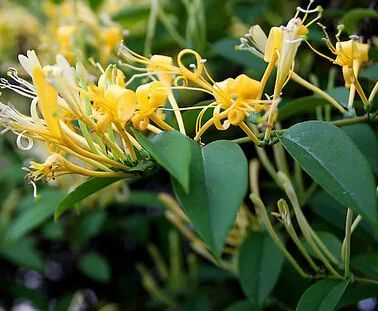
(IV) Harvesting and Processing
1. Harvesting: Timely harvesting is crucial for improving the yield and quality of Honeysuckle. According to current cultivation techniques, Honeysuckle can be harvested four times a year. The first and second harvests yield more flowers, while the latter two yield less. Generally, the first harvest occurs in late May, the second in mid to late June, and the third and fourth in July and August, respectively. The flowering stages can be divided into seven categories: young buds (green, about 1 cm), three green (green, about 2.2-2.4 cm), two white (light greenish-white, about 3-3.9 cm), large white (white, about 3.8-4.6 cm), silver flower (just opened, white flowers about 4.2-4.8 cm), golden flower (yellow flowers, about 4-4.5 cm), and withered flowers (brownish-yellow). The best medicinal materials are large white, two white, and three green, followed by silver flower and golden flower. The content of chlorogenic acid decreases from young buds to fully opened flowers. In production, it is essential to grasp the timing and standards for harvesting based on the flowering patterns of Honeysuckle. The most suitable time for harvesting is when the flowers are large and white, just opened. Harvesting too early results in small, greenish buds with low yield; harvesting too late may lead to fully opened flowers, reducing quality. Harvesting should be done in the morning, preferably before the dew dries. Since Honeysuckle flowers open in a concentrated manner, it is crucial to harvest promptly. For flowers that meet the harvesting standards, pick from the outside in, from the bottom up, taking care not to break the branches.
2. Processing: Honeysuckle should be dried or baked immediately after harvesting. Spread the flowers on drying trays, laying them on clean stones, cement floors, or mats, with a thickness of about 2 cm, aiming to dry them on the same day. Do not turn the flowers while drying to prevent them from turning black. It is best to use baskets or drying trays for drying. If it rains or if they cannot be dried on the same day, they should be collected and stored promptly. The drying method is simple and cost-effective, widely adopted in production areas.
In regions where flowers are concentrated, to ensure the quality of Honeysuckle, or in rainy weather, drying methods should be employed. Different drying rooms can be designed according to local conditions, with farmers typically using natural baking methods, placing a coal stove in the center of the room (the number depends on the room size) to naturally expel moisture, generally drying at around 40°C without temperature changes.
A slightly more complex drying room design includes two stove openings at one end, with a backflow stove design inside, leaving a chimney and skylight on the roof, and a pair of ventilation openings on the front and back walls 30 cm above the ground. During drying, a variable temperature method is used, with the initial drying temperature not exceeding 30-35°C for the first 2 hours, then increasing to about 40°C. After 5-10 hours, the indoor temperature should be maintained at 45-50°C, and after 10 hours, most of the moisture should be expelled, then increase the temperature to 55°C for rapid drying. Generally, drying for 12-20 hours can completely dry the flowers. During drying, do not touch or move the flowers, as this can cause them to turn black. If drying is stopped before the flowers are fully dry, they may heat up and spoil. Experiments in Pingyi County, Shandong, showed that the rate of first-class dried flowers reached over 95%, while the rate for sun-dried flowers was only 23%. The drying method is an effective measure to improve product quality in Honeysuckle production. Dried Honeysuckle should be stored in a cool, dry place to prevent moisture and pests.
3. Specification and Grading of Products: According to the quality of silver flowers and traditional production and sales habits, they are divided into three types: Mi Yin Hua (密银花, Dense Silver Flower), Ji Yin Hua (济银花, East Silver Flower), and Shan Yin Hua (山银花, Mountain Silver Flower), each further divided into several grades:
(1) Mi Yin Hua is referred to as “Mi Hua” in the Hong Kong market.
First Grade: Flower buds are rod-shaped, thicker at the top and thinner at the bottom, slightly curved. The surface is greenish-white, with thick corollas and a slightly hard texture, giving a fragrant aroma and a sweet, slightly bitter taste. No open flowers, broken flower buds, or yellow strips exceed 5%. No black strips, black heads, leaves, impurities, pest damage, or mold.
Second Grade: Open flowers do not exceed 5%, broken flower buds, and yellow strips do not exceed 10%, with no black strips or leaves. Other standards are the same as first grade.
Third Grade: Open flowers and black strips do not exceed 30%, with no leaves, and other standards are the same as first grade.
Fourth Grade: Both flower buds and open flowers are present, with no color distinction. Leaves do not exceed 3%. No impurities, pest damage, or mold.
(2) Ji Yin Hua is referred to as “Wu Hua” in the Hong Kong market.
First Grade: Flower buds are rod-shaped and robust, thicker at the top and thinner at the bottom, slightly curved, with a surface of yellow, white, and green colors. They have a fragrant aroma and a sweet, slightly bitter taste. Open flowers do not exceed 5%. No tender buds, black heads, leaves, impurities, pest damage, or mold.
Second Grade: Flower buds are thinner, with open flowers not exceeding 15%, and black heads not exceeding 3%. No leaves, impurities, pest damage, or mold.
Third Grade: Flower buds are small, with open flowers not exceeding 25%, black heads not exceeding 15%, and leaves not exceeding 1%, with no impurities, pest damage, or mold.
Fourth Grade: Both flower buds and open flowers are present, with no color distinction, and leaves do not exceed 3%. No impurities, pest damage, or mold.

Honeysuckle Network
WeChat ID: sdjyhxh
Editor for this issue: Lian Hui
Organizing Unit: Shandong Honeysuckle Industry Association
Official Website: http://www.sdjyh.gov.cn

